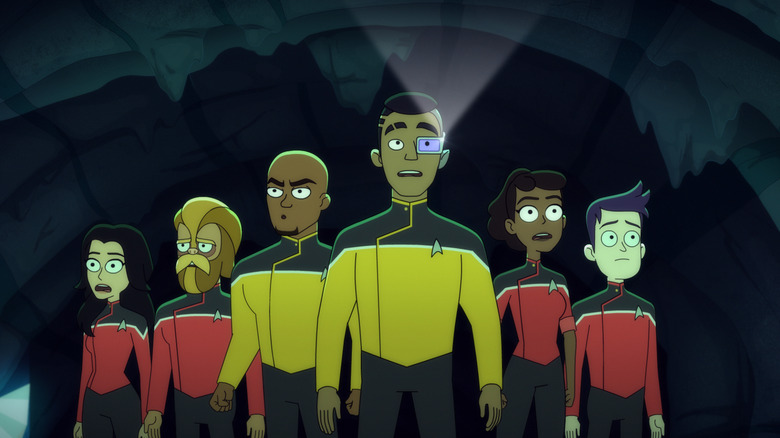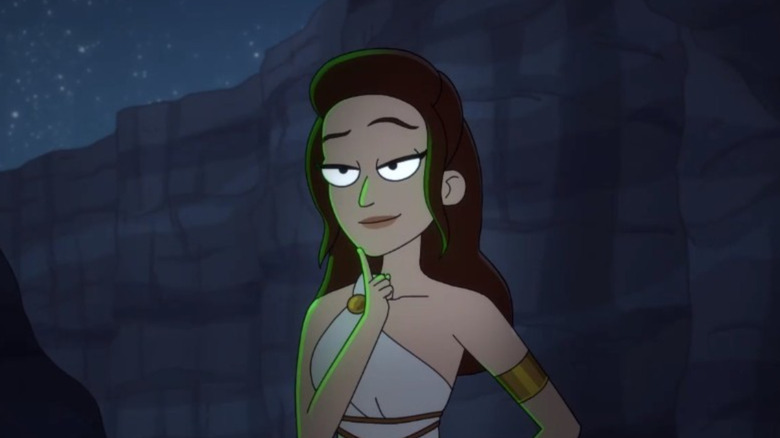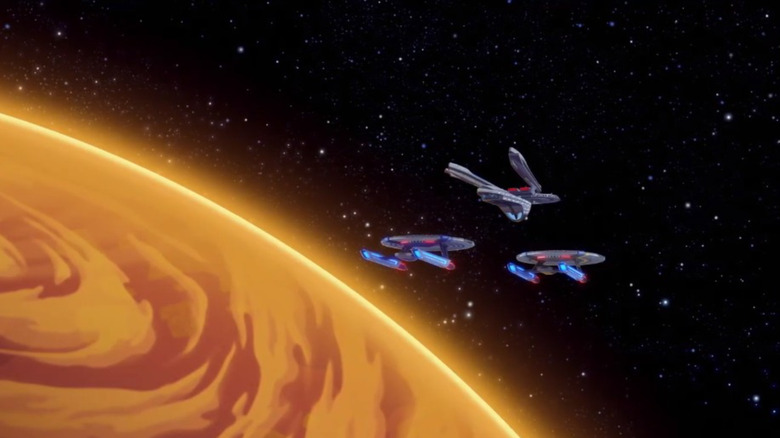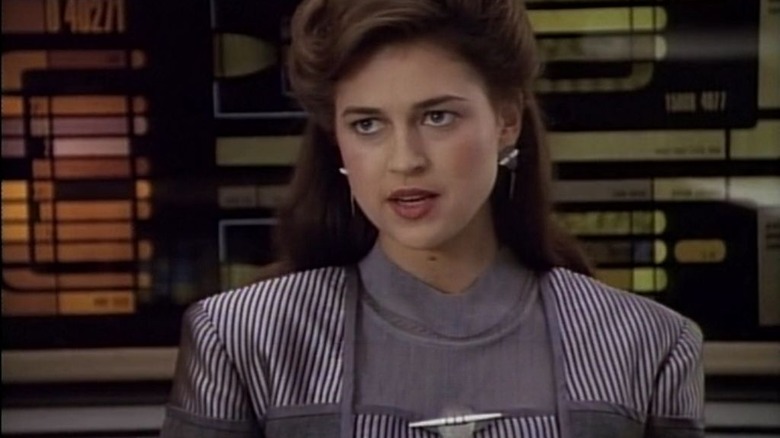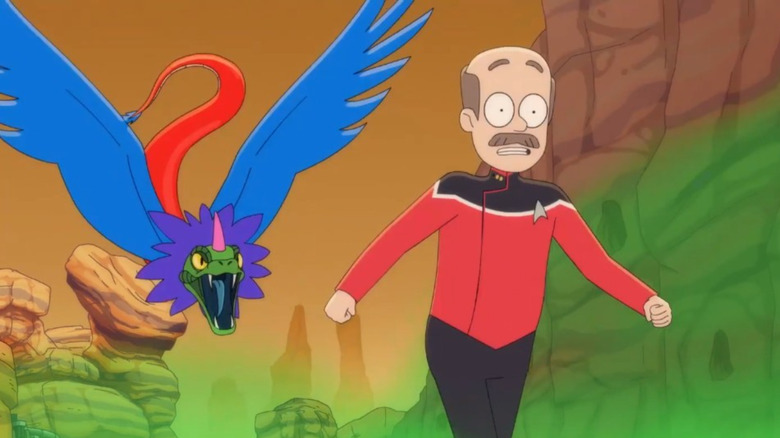The 5 Best Easter Eggs And References In Star Trek: Lower Decks Season 3, Episode 3
In the third episode of the third season of "Star Trek: Lower Decks," called "Mining the Mind's Mines," the crew of the U.S.S. Cerritos has been tasked with rescuing a team of geologists from a planet populated by silicon-based life forms called the Scrubble. Commander Ransom (Jerry O'Connell) bemoans the fact that Federation scientists often play fast-and-loose with safety, and it's always Starfleet who has to come clean up their research missions when they go afoul.
On the Scrubble planet, mysterious glowing crystal orbs read a victim's thoughts, briefly manifest their deepest desires in the real world, and then turn their victims into statues. Throughout the episode, characters will have to come up with quick, embarrassed excuses when some of their deepest desires appear in front of their peers. Ensign Mariner (Tawney Newsome), for instance, can't help but reveal that she's developed feelings for her Andorian co-worker Jennifer. Ensign Boimler's deepest desires involve his superior officer asking him to help out in an important mission; it's kind of sad that even in fantasy, Boimler is never the one in charge.
As is the mission statement of "Lower Decks," "Mind's Mines" is full of fun "Trek" references and clever Easter Eggs that an astute Trekkie will spot. Here are a few the keen eyes at /Film spotted.
Seductive, mind-reading, shape-shifting alien brain parasites
If going by production order — which, Trekkies will tell you, is the only correct order in which to watch the original series — then "The Man Trap" is the show's fifth episode. Broadcast order (feh) had it running first. Either way, a precedent was set early on "Star Trek," and audiences would frequently see magical sci-fi creatures of devices that could read the minds of Starfleet officers and physically manifest their desires. In "The Man Trap" (September 8, 1966), Kirk (William Shatner) found an intruder on his ship in the form of a shapeshifting alien called simply the M-113 Creature. The creature is a leech monster who, as a defense mechanism, can appear differently to different people.
In the episode "Shore Leave" (December 29, 1966), the crew of the Enterprise finds themselves on a planet that can read their thoughts and instantly construct robots based on whatever they're thinking of. Kirk thinks of an old school rival. Sulu (George Takei) dreams of a handgun. Dr. McCoy (De Forest Kelley) dreams of the White Rabbit from "Alice in Wonderland."
In the "Star Trek: The Next Generation" episode "Where No One Has Gone Before" (October 26, 1987), the Enterprise is stranded in a distant part of the universe that, just as a natural phenomenon, manifested thoughts as reality, and Worf (Michael Dorn) created a beloved childhood pet. Picard (Patrick Stewart) had tea with his dead mother.
In the "Star Trek: Deep Space Nine" episode "If Wishes Were Horses" (May 17, 1993), the station crew finds figures like Rumpelstiltskin (Michael Anderson) wandering the station, as well as a hornier doppelgänger of Jadzia Dax (Terry Farrell).
It seems that wishes do come true.
The U.S.S. Hood
Only glimpsed briefly, and only mentioned by name once, "Mining the Mind's Mines" sees two California-class vessels coming to the aid of the U.S.S. Hood, an Excelsior-class vessel that is in charge of the mission. The Hood, Trekkies will know, has a storied off-to-the-side history throughout "Trek." Most notably, the Hood was the first ship that Commander Riker (Jonathan Frakes) was assigned to early in his Starfleet career, serving under Captain Robert DeSoto (Michael Cavanaugh). Geordi LaForge (LeVar Burton) also once mentioned that he, too, served aboard the Hood at one point.
The Hood would appear multiple times throughout "Next Generation," probably because the show's FX department only had so many models to go around, and the Hood was always a fun one to put next to the Enterprise. As such, the Hood was mentioned in the episodes "Tin Man," "The Defector," "Allegiance," and was seen in larger fleets in battle-based episodes. The Hood would also get involved in scrapes with the Dominion during "Deep Space Nine," and its name would be mentioned myriad times throughout.
That the Hood is still in operation all these years later speaks to the tenacity of the ship. The Hood, incidentally, was named after Rear Admiral Sir Horace Lambert Alexander Hood, a World War I officer for the Royal Navy.
Dr. Leah Brahms
Ensign Rutherford (Eugene Cordero) is an engineer who loves machines and technical stuff, so it makes perfect sense that his ultimate fantasy should be an apparition of Dr. Leah Brahms.
First mentioned in the NextGen episode "Booby Trap" (October 30, 1989), Dr. Leah Brahms (Susan Gibney) was one of the designers who was instrumental in the design of the Enterprise-D. In "Booby Trap," Geordi has to find a way to speed up power transfers on the ship in order to escape a millennia-old space snare that was draining power from all its systems. To better understand the ship, Geordi creates a holographic simulation of Brahms, and they develop a good rapport. Geordi ends up kind of developing a crush on the hologram, and the episode ends with a kiss.
If that seems a little creepy — kissing a simulation of a real person — Geordi will be taken to task in "Galaxy's Child" (March 11, 1991) wherein he will has an opportunity to meet the real Dr. Brahms. She discovers his lovey-dovey simulation and is horrified. Eventually, the two work together to solve a crisis, and Dr. Brahms has no hard feelings ... as now she can go home to her husband. Geordi is left alone. In the series finale "All Good Things..." (May 23, 1994), an alternate future timeline reveals that Geordi and Dr. Brahms ended up getting married and having children of their own.
Kukulkan
When the mind-reading crystal balls crack open, their powers are intensified, and they begin manifesting nightmares instead of dreams. Some of the creatures that appear are merely terrifying apparitions that anyone would be scared of: Klingon clowns with bat'leth arms, giant Borg snakes, etc. One of the manifestations is a red winged serpent that is namechecked as Kukulkan.
Kukulkan is a fun reference to a creature encountered in a "Star Trek: The Animated Series" episode "How Sharper Than a Serpent's Tooth" (October 5, 1974) wherein the Enterprise finds an ancient Mayan city on a distant planet and awakens a legitimate Mayan god. Kukulkan announces that he once lived on Earth where he was worshiped. Now awakened, he plans on returning to get his old gig back. Kirk announces, in a daring notion for a kids' show, that Earth has outgrown the need to worship; the planet, he explains, is now wholly atheist. Kirk thanks Kululkan for guiding Earth people through an early phase of development, but now is the time to kindly retire as a god. Kukulkan does.
The Kukulkan seen in "Lower Decks" has nothing to say; it's just a big scary flying monster. But his appearance is a fun nod.
Silicon-based life forms
The Scrubble are but the latest in a long series of "Star Trek" species that appear to be silicon based. Although the actual scientific possibility of silicon-based life seems to have been largely disproven, the possibility of a living rock is too tantalizing for the writers of sci-fi shows to give up. The two elements are right next to each other on the periodic table. As we all know, carbon and silicon can form ionic compounds by gaining four electrons, forming the carbide anion (C4-) and silicide anion (Si4-), but they more frequently form compounds through covalent bonding.
As such, mineral-based lifeforms crop up on "Trek" with frequency. In "Devil in the Dark" (March 9, 1967) Kirk and Spock (Leonard Nimoy) discover a rock monster called a horta that killed people to protect its eggs. In "The Savage Curtain" (March 7, 1969), Kirk and Spock are forced into hand-to-hand combat by an all-powerful, lava-like Excalbian. On NextGen, "Home Soil" (February 22, 1988) sees the discovery of sentient grains of sand, and "Silicon Avatar" (October 14, 1991) sees the second appearance of a creature simply called The Crystalline Entity.
This is nothing to say of the multiple references throughout "Trek" to the Tholians, an antagonistic species made of crystal. The Scrubble are merely the latest in a long line of such species.
